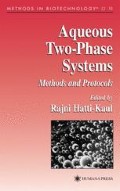Abstract
A crucial step in many biochemical studies is the separation and purification of the individual structures of interest. For cells, cell organelles, and membrane fragments, the use of aqueous two-phase partition has become an important tool. The basis for separation in these phase systems is the surface properties of the material, and the method, therefore, nicely complements the more traditional centrifugation techniques. Excellent separations have sometimes been obtained in just one or a few partition steps. However, in most instances, a single partition step only gives a partial or incomplete separation of components. By a multiple-extraction procedure, the resolving power can be drastically increased and components with only small differences in surface properties can be separated.
Access this chapter
Tax calculation will be finalised at checkout
Purchases are for personal use only
References
Walter, H. and Krob, E. J. (1978) Surface properties of rat reticulocytes during maturation as measured by partition membrane charge associated changes discerned prior to membrane lipid related changes. Br. J. Haematol. 38, 43–56.
Westrin, H. and Backman, L. (1983) Association of rabbit muscle glycolytic enzymes with filamentous actin. A countercurrent distribution study at high ionic strength. Eur. J. Biochem. 136, 407–412.
Blomquist, G., Hartman, A., Shanbhag, V. P., and Johansson, G. (1974) Separation of isoenzymes by partition in aqueous polymeric 2 phase systems. Eur. J. Biochem. 48, 63–69.
Larsson, C., Collin, C., and Albertsson, P.-Å. (1971) Characterization of three classes of chloroplasts obtained by counter-current distribution. Biochim. Biophys. Acta 245, 425–438.
Åkerlund, H.-E. and Andersson, B. (1983) Quantitative separation of spinach thylakoids into photosystem II enriched inside-out vesicles and photosystem I enriched right-side-out vesicles. Biochim. Biophys. Acta 725, 34–40.
Birkenmeier, G., Kopperschläger, G., Albertsson, P.-Å., Johansson, G., Tjerneld, F., Åkerlund, H.-E., Berner, S., and Wickström, H. (1987) Fractionation of proteins from human serum by counter-current distribution. J. Biotechnol. 5, 115–130.
Johansson, G., Joelsson, M., and Åkerlund, H.-E. (1985) Affinity-ligand gradient technique for purification of enzymes by countercurrent distribution. J. Biotechnol. 2, 225–238.
Johansson, G., Andersson, M., and Åkerlund, H.-E. (1984) Countercurrent distribution of yeast enzymes with polymer-bound triazine dye affinity ligands. J. Chromatogr. 298, 483–493.
Johansson, G., Åkerlund, H.-E., and Olde, B. (1984) Liquid-liquid extraction of membranes from calf brain using conventional and centrifugal counter-current distribution techniques. J. Chromatogr. 311, 277–290.
Ollero, M., Muino-Blanco, T., Lopez-Perez, M. J., and Cebrian-Perez, J. A. (1996) Surface changes associated with ram sperm cryopreservation revealed by countercurrent distribution in an aqueous two-phase system: effect of different cryoprotectants. J. Chromatogr. 680, 157–164.
Garcia-Lopez, N., Ollero, M., Cebrian-Perez, J. A., and Muino-Blanco, T. (1996) Reversion of thermic-shock effect on ram spermatozoa by adsorption of seminal plasma proteins revealed by partition in aqueous two-phase systems. J. Chromatogr. 680, 137–143.
Pascual, M. L., Cebrian-Perez, J. A., Lopez-Perez, M. J., and Muino-Blanco, T. (1996) Short-term inhibition of the energy metabolism affects motility but not surface properties of sperm cells. Biosci. Rep. 16, 35–40.
Truust, H. and Johansson, G. (1996) Fractionation of wheat proteins by countercurrent distribution using aqueous two-phase systems containing propionic acid. J. Chromatogr. 680, 71–80.
Albertsson, P.-Å. (1965) Thin layer countercurrent distribution. Anal. Biochem. 11, 121–125.
Albertsson, P.-Å. (1986) Partition of Cell Particles and Macromolecules, 3rd ed. Wiley Interscience, New York.
Åkerlund, H.-E. (1984) Apparatus for countercurrent distribution in a centrifugal acceleration field. J. Biochem. Biophys. Meth. 9, 133–142.
Editor information
Editors and Affiliations
Rights and permissions
Copyright information
© 2000 Humana Press Inc.
About this protocol
Cite this protocol
Åkerlund, HE. (2000). Partition by Countercurrent Distribution (CCD). In: Hatti-Kaul, R. (eds) Aqueous Two-Phase Systems: Methods and Protocols. Methods in Biotechnology™, vol 11. Humana Press. https://doi.org/10.1385/1-59259-028-4:55
Download citation
DOI: https://doi.org/10.1385/1-59259-028-4:55
Publisher Name: Humana Press
Print ISBN: 978-0-89603-541-6
Online ISBN: 978-1-59259-028-5
eBook Packages: Springer Protocols

